Drawings of constellations and their names. Constellations from ancient atlases
By the decision of the International Astronomical Union, it was assumed that the number of constellations in the entire celestial sphere is 88, and 47 of them were named approximately 4,500 years ago. These are Big Dipper, Ursa Minor, Dragon, Bootop, Taurus, Aquarius, Capricorn, Sagittarius, Libra, Virgo, Scorpio, Gemini, Cancer, Leo, Aries, Pisces, Orion, Big Dog, Hare, Hercules, Arrow, Dolphin, Eridan, Whale, Southern Fish, Southern Crown, Little Dog, Centaurus, Wolf, Hydra, Bowl, Raven, Veronica's Hair, Southern Cross, Little Horse, Northern Crown, Ophiuchus, Charioteer, Tsefei, Cassiopeia, Andromeda, Pegasus, Perseus, Lyra, Lebed , Eagle and Triangle. As you can see, most of the names taken from Greek mythology.
| |
This number has been preserved by the ancient Greek astronomer Hipparch (II century BC) in his star catalog. The same constellations were described by the Alexandrian scientist Claudius Ptolemy (2nd century AD) in the famous work Almagest. Such were the knowledge of constellations before the beginning of the seventeenth century. In 1603g. German astronomer Johann Bayer added 11 new to the ancient constellations: Peacock, Toucan, Crane, Phoenix, Flying Fish, South Hydra, Golden Fish, Chameleon, Bird of Paradise, Southern Triangle and Native American. In 1690 the star atlas of the Polish astronomer Jan Hevelius Firmamentum Sobiescianum sive Uranographia is published. In the "emptiness" between the ancient constellations, Hevelius placed 11 more constellations: Giraffe, Fly, Unicorn, Dove, Hounds, Dogs, Fox, Lizard, Sextant, Little Lion, Lynx and Shield. It is interesting to note that, referring to these constellations, the Hevelius guide I have very original considerations. As he himself explained, for example, the Lynx constellation, he assigned this name because in the area occupied by this constellation, the stars are so weak that "you need to have lynx eyes to see and distinguish them."
In the representation of the ancient Greeks, Uranus ruled the kingdom of heaven, and Urania was the muse of heaven. The name of the heavenly king was named the great planet of the solar system. Uranus and Urania are derived from the Greek name for the sky- "Urano". The word "uranography" is associated with celestial mapping, like geography and earth mapping. However, the very word "uranograph" today, few people know. How does the uranograph create a map? The geographer depicts the real physical form of the surface of our planet, but the sky is not so simple to depict. What we regard as the sky or the firmament of heaven is a view of the Universe from the surface of our Earth. In the early era, people depicted the sky with globes. On their surface, imaginary drawings of constellations or different images of a person, mysterious creatures and other objects, as well as real-life stars, were applied. There are relatively few celestial globes of the ancient period. Another type of early celestial globes was the armillary sphere, which can also be called the "skeleton of the sky". This open design clearly demonstrated the basic coordinate circles and was intended for solving astronomical and, more often, astrological tasks. The astrolabe was derived from the invention of the armillary sphere. The main disadvantage of the celestial globe, in addition to its bulkiness, is that the celestial objects on it are mirrored - inverted. This led to the creation of maps that could show the real picture of the sky. Some early star maps made in the West, like celestial globes, showed only drawings of the constellations without stars. An outstanding astronomer Jan Hevelius did a great uranographic work in the 17th century.
The sky map of Jan Hevelius. JSC "Obraz" St. Petersburg
Hevelius was a very educated and cultured man of the Renaissance. He owned many professions: he was a brewer, a mayor, a skilled engraver and, of course, one of the leading astronomers of his time.
The star atlas of the Firmamentum Sobiescianum sive Uranographia contains a catalog of 1564 stars visible to the naked eye, published in 1690 by Elizabeth Hevelius after the death of her husband. This very talented woman was his constant scientific partner and even helped him in astronomical observations. Hevelius himself measured the positions of the stars, which were then entered in his catalog and atlas. Unlike Bayer, who took advantage of Tycho Brahe’s ready-made observations, Hevelius himself measured the positions of the stars, which were then recorded in his catalog and atlas. There is a certain similarity between the works of Bayer and Hevelius. The fact is that an astronomer from Danzig made his observations from his private observatory "Stellalabum" ("Stellaburgum"), which was not too different from the Brahe observatory created a century earlier. Both carried out their measurements without using any optical instruments, except for the naked eye, although in the days of Hevelius the telescope was already invented. He used to observe the old measuring instruments and the naked eye. Hevelius categorically did not want to use a telescope for positional measurements. This may seem strange, but in the history of astronomy and technology, such things are quite common. Hevelius believed that the naked eye as a measuring tool was geometrically “cleaner” than a telescope in which lenses could contribute their own mistakes.
Jan Hevelius was born on January 28, 1611 in Gdansk in the family of a merchant. Astronomy fascinated in his youth. He studied law in Holland, England and France, visited Prague, where he got acquainted with the Observatory of Tycho Brahe. In 1639, after the death of his father, he returned to Gdansk. He continued the work of his father; he spent all his income on astronomy. In 1641, he built the Stellalabum observatory in his house, he made the tools himself and made many observations. Together with his wife Elzhbeta he made a map of the Moon, which was distinguished by great accuracy, published it in the book Selenography (Selenographia, 1647). In 1661, watched the passage of Mercury across the solar disk. Compiled a catalog of 1564 stars, in the work Cometography (Cometographia, 1668) gave the first systematic description and outlined the history of all comets observed by that time, he himself discovered four comets. He became a member of the Royal Society of London. Already after the death of the scientist, the star catalog and sky atlas Firmamentum Sobiescianum sive Uranographia prepared by him was published. The catalog contains the results of observations of the positions of 1564 stars visible above the horizon in Gdansk, and the atlas describes 11 new constellations (the names of some of them have survived to the present day). Hevelium died in Gdansk on January 28, 1687.
Hevelius was not only an adherent of an aging observational technique, he also firmly adhered to the old-fashioned tradition of depicting the sky. Hevelius preferred mirror inverted stellar maps, which showed the constellations not as they really are, but visible from some imaginary point "outside" the celestial sphere. So constellations were depicted on celestial globes - this was demanded by the geometry of the celestial globe. The main advantage of flat maps compared to globes, besides their ease of circulation, is that they display a real picture of the starry sky. Why did Hevelius still portray the sky in an uncomfortable, mirror-like, inverted way? Probably, he wanted to maintain harmony with the celestial globes, which were still quite common at that time. Atlas Hevelius stands out for its decoration. Each drawing of Hevelius engraved on its own defect-free method. Unlike Bayer, he shows the adjoining drawings of the constellations. All drawings are made using a unique typographic pressing technology. Hevelius introduces a number of new constellations that have survived to the present, such as the Hounds Dogs (Canes Venatici), the Lizard (Lacerta), the Little Leo (Leo Minor), the Lynx, the Sextant, the Scutum and the Vulpecula ). Some of the constellations introduced by Hevelius have ceased to exist at the present time.
Hevelius was also famous for the fact that, using only the naked eye, he measured the positions of stars with an accuracy of less than one angular minute. As a result, the accuracy of his atlas became of the same order as maps and atlases of our time. (Although the position of the star can be determined today with an accuracy of small fractions of a second arc, such a small angular distance cannot be reflected on conventional maps, the accuracy of which is 1 arc minute. So the accuracy that Hevelius achieved is quite enough even for modern maps) .
LARGE AND SMALL BEARS, HAIR
There are many legends about Big and Little Dipper. Here is one of them. Sometime in ancient times, King Lycaon, who ruled Arcadia, had a daughter named Callisto. Her beauty was so extraordinary that she ventured to compete with the Hero, the goddess and spouse of the almighty supreme god Zeus. Jealous Hera finally avenged Callisto: Using her supernatural power, she turned her into an ugly bear. When Callisto's son, a young Arkad, once returning from a hunt, saw a wild beast at the door of his house, he was unaware of anything, almost killed his mother bear. Zeus prevented this, he retained the hand of the Arcade, and Callisto forever took him to heaven, turning him into a beautiful constellation - the Big Dipper. Callisto's beloved dog was also turned into the Little Dipper. Arkad did not stay on Earth either: Zeus turned him into the constellation Bootes, who was doomed to forever guard his mother in the sky. The main star of this constellation is called Arcturus, which means "bear guardian". Ursa Major and Ursa Minor are non-walking constellations, most noticeable in the northern sky. There is another legend about circumpolar constellations. Fearing the god Kronos, who was devouring babies, the mother of Zeus, Rhea, hid her newborn in a cave, where he was fed, in addition to the goat Amalthea, two bears - Melissa and Gelika, subsequently placed on the sky. Sometimes Melissa is called Kinosura, which means "dog's tail." In the legends of different nations, the Big Dipper is often called a chariot, a wagon, or simply seven bulls. Next to the Mizar star (from the Arabic word “horse”), the second, or middle, star in the handle of the Big Dipper is barely noticeable Alcor star (in Arabic, this means “ rider "," rider "). By these stars you can check your eyesight; each star should be visible to the naked eye.
| |
|
|
PERSEUS, ANDROMEDA, CAPE, CASSIOPE
The myth of the hero Perseus is reflected in the names of the starry sky. Once upon a time, according to the ancient Greeks, Ethiopia was ruled by a king named Cepheus and a queen called Cassiopeia. They had the only daughter beautiful Andromeda. The queen was very proud of her daughter and once had the imprudence to boast of her beauty and the beauty of her daughter before the mythical inhabitants of the sea - the Nereids. Those were very angry because they thought that they were the most beautiful in the world. The Nereids complained to their father, the god of the seas, Poseidon, that he punish Cassiopeia and Andromeda. And the mighty lord of the seas sent a huge sea monster, Kit, to Ethiopia. Fire burst from Whale’s mouth, black smoke poured from its ears, its tail was covered with sharp thorns. The monster devastated and burned the country, threatened to kill all the people. In order to appease Poseidon, Cepheus and Cassiopeia agreed to give their beloved daughter to be eaten by the monster. Beauty Andromeda was chained to a coastal cliff and meekly awaited her fate.
Meanwhile, on the other side of the world, one of the most famous legendary heroes - Perseus - accomplished an extraordinary feat. He entered the island where the Gorgons lived - monsters in the form of women who had snakes in their bodies instead of hair. The gorgon’s gaze was so terrible that anyone who dared to look them in the eyes instantly petrified. But nothing could stop the fearless Perseus. Seizing the moment when the gorgons fell asleep. Perseus cut off the head of one of them, the most important, the most terrible - the Gorgon Medusa.
At the same time, winged horse Pegasus fluttered out of Medusa's huge torso.
Perseus jumped on Pegasus and rushed home. Flew over Ethiopia, he noticed Andromeda chained to the rock, which the terrible Keith was about to seize. Brave Perseus entered into a fight with the monster. This struggle continued for a long time. Perseus's magical sandals lifted him into the air, he thrust his curved sword into Kit's back. Kit roared and rushed at Perseus. Perseus directed at the monster the deadly gaze of Medusa's severed head, which was attached to his shield. The monster is petrified and drowned, becoming an island. And Perseus relaxed Andromeda and brought her to the palace of Cepheus. Delighted the king gave Andromeda wife Perseus. In Ethiopia, a cheerful feast lasted for many days. And in the sky, the constellations of Cassiopeia, Cepheus, Andromeda, Perseus are burning in the sky. On the star map you will find the constellation of Keith, Pegasus. So the ancient myths of the Earth are reflected in the sky.
PEGASUS
Next to Andromeda is the constellation Pegasus, which is especially clearly seen at midnight in mid-October. The three stars of this constellation and the alpha star Andromeda form a figure that astronomers have received the name "Big Square". It can be easily found in the autumn sky. Winged horse
Pegasus emerged from the decapitated Perseus of the body of Medusa Gorgon, but did not inherit anything bad from her. He was the favorite of nine muses - daughters of Zeus and the goddess of memory Mnemosyne, on the side of Mount Helikon he beat out the source of Hippocrea, the water of which brought inspiration to the poets. And another legend in which Pegasus is mentioned. The grandson of King Sisyph Bellerophon was supposed to kill the fire-breathing monster Chimera (Chimera - in Greek "goat").
The monster had a lion head, a goat’s body and a dragon’s tail. Bellerophon managed to defeat Chimera with the help of Pegasus. One day he saw a winged horse and the desire to take possession of it seized the young man. In the dream, the goddess Athena, the beloved daughter of Zeus, the wise and warlike, patroness of many heroes, appeared to him. She gave Bellerophon a wonderful, pacifying bridle of horses. With it, Bellerophon caught Pegasus and went into battle with Chimera. Rising high into the air, he threw arrows at the monster, until he gave up the ghost. But Bellerophon was not satisfied with his success, but wished on a winged horse to rise to the sky, to the dwelling of the immortals. Zeus, having learned about it, was angry, infuriated Pegasus, and he threw his rider to the ground. Pegasus then climbed to Olympus, where he wore lightning Zeus. The main attraction of the Pegasus constellation is a bright globular cluster. Through the binoculars you can see a round glowing misty speck, the edges of which sparkle like the lights of a large city visible from the aircraft.
It turns out that this globular cluster contains about six million suns!
| |
HAIR OF VERONICA
The ancient constellation Leo in the sky had a rather large "territory", and Leo himself was the owner of a magnificent "tassel" on the tail. But in 243 BC he lost her. There was a funny story, which is legendary. The Egyptian king Ptolemy Evergeta had a beautiful wife, Queen Veronica. Her gorgeous long hair was especially gorgeous. When Ptolemy went to war, his grieved spouse swore an oath to the gods: if they kept her beloved husband safe and sound, sacrifice their hair. Soon, Ptolemy safely returned home, but upon seeing the cropped spouse was upset. The royal couple somewhat calmed astronomer Konon. declaring that the gods lifted Veronika's hair to the sky, where they were supposed to decorate spring nights.
| |
TAURUS
Among the ancient peoples, the most important was the constellation Taurus, since the new year began in the spring. In the zodiac, Taurus is the most ancient constellation, since cattle breeding played a huge role in the life of ancient peoples, and the bull (calf) was tied to the constellation, where the sun seemed to win the winter and heralded the arrival of spring and summer. In general, many ancient peoples revered this animal, considered it sacred. In ancient Egypt was the sacred bull Apis, who was worshiped during his lifetime and whose mummy was solemnly buried in a magnificent tomb. Every 25 years, Apis was replaced with a new one. In Greece, the bull also enjoyed great honor. On Crete, the bull was called Minotaur. The heroes of Hellas Heracles, Theseus, Jason pacified the bulls. The Aries constellation was also highly revered in antiquity. The supreme god of Egypt, Amon-Ra, was depicted with a ram's head, and the road to his temple was an avenue of sphinxes with a ram's head. In the sky, by the way, there are a number of constellations reflecting the Argo Ship. The alpha star (the brightest) of this constellation is called Gamal (in Arabic “adult sheep”). The brightest star in the constellation Taurus is called Aldebaran.
| < |
TWINS
In this constellation, two bright stars are very close to one another. They received their name in honor of the Argonauts of the Dioscuri — Castor and Pollux — the twins, sons of Zeus, the most powerful of the Olympic gods, and Leda, the frivolous earthly beauty, the brothers Helen, the beautiful culprit of the Trojan War. Castor was known as a skilled charioteer, and Pollux as an unsurpassed fist fighter. They participated in the campaign of the Argonauts and the Kalidonian hunt. But once the Dioscuri did not share the prey with their cousins, the giants Idas and Linkey. In the battle with them, the brothers were badly wounded. And when Castor died, the immortal Pollux did not want to part with his brother and asked Zeus not to separate them. Since then, at the behest of Zeus, the brothers spend half a year in the realm of gloomy Aida, and half a year on Olympus. There are periods when, on the same day, the star Castor is visible against the background of the morning dawn, and Pollux is visible in the evening. Perhaps it was this circumstance that gave rise to the birth of a legend about brothers living in the realm of the dead, now in heaven. The Dioscuri brothers were considered in ancient times the patrons of sailors caught in a storm. And the appearance on the masts of ships in front of a thunderstorm "Fires of Saint Elmo" was considered a visit to the Twins by their sister Helen. The lights of Saint Elmo are the luminous discharges of atmospheric electricity observed on pointed objects (tops of masts, lightning rod, etc.). Dioscuri was also honored as guardians of the state and patrons of hospitality. In ancient Rome, the silver coin "Dioscuri" with the image of stars was in circulation.
| |
CRAYFISH
The constellation of Cancer is one of the least visible zodiac constellations. His story is very interesting. There are several rather exotic explanations of the origin of the name of this constellation. For example, it was seriously claimed that the Egyptians had been placed in this area of the sky of Cancer as a symbol of destruction and death, because this animal feeds on carrion. Cancer moves its tail forward. About two thousand years ago, the constellation of Cancer was the point of the summer solstice (ie, the longest daylight hours). The sun, having reached the extreme distance to the north at that time, began to “back up” backwards. The length of the day gradually decreased. According to classical ancient mythology, a huge sea Cancer attacked Hercules when he fought with the Lernean Hydra. The hero crushed him, but the goddess Hera, who hated Hercules, placed Cancer in the sky. The Louvre contains the famous Egyptian circle of the zodiac, in which the constellation of Cancer is located above all others.
| |
A LION
About 4.5 thousand years ago in this constellation was the point of summer solstice, and the Sun was in this constellation in the hottest time of the year. Therefore, among many peoples, it was Leo that became the symbol of fire. The Assyrians called this constellation the “great fire”, and the Chaldeans associated the fierce lion with a fierce heat that lasted every summer. They believed that the Sun receives additional strength and warmth, being among the stars of the lion. In Egypt, this constellation was also associated with the summer period: flocks of lions, fleeing from the heat, moved from the desert to the valley of the Nile, which at that time spilled. Therefore, the Egyptians placed on the gates of the irrigation canal locks, which sent water to the fields, images in the form of a lion's head with an open mouth.
| |
Leo constellation occupies a large area of the sky. Stars of the first, second, third, fourth and fifth magnitudes. The star of the first magnitude is Regulus, or the Heart of Leo, a blue, nautical star. Its luminosity is 150 times more solar. In the tail of the constellation is a star of the second magnitude Denebol.
VIRGO
The Virgo constellation, located near Leo, this constellation sometimes seemed to be a fabulous sphinx - a mythical creature with the body of a lion and the head of a woman. Often in early myths, the Virgin was identified with Rhea, the mother of the god Zeus, the wife of the god Kronos. Sometimes they saw Themis, the goddess of justice, who, in her classic guise, holds the scales in her hands (the zodiac constellation next to Virgo). There is evidence that in this constellation the ancient observers saw Astrea, the daughter of Themis and the god Zeus, the last of the goddesses who left the Earth at the end of the Bronze Age. Astrea - the goddess of justice, a symbol of purity and innocence, left the Earth because of human crimes. Such we see the Virgin in ancient myths. The maiden is usually depicted with a rod of Mercury and an ear. Spica (in the lane. From Latin "ear") is named the brightest star of the constellation. The very name of the star and the fact that Virgo was depicted with an ear in his hands indicates the connection of this star with the agricultural activities of man. It is possible that the beginning of any agricultural work coincided with its appearance in the sky.
| |
A large constellation of stars of the first, second and fourth magnitudes. The star of the first magnitude is the bluish-white star Spica, with a luminosity of 750 times that of the sun. Currently in the constellation is the point of the autumn equinox.
LIBRA
Indeed, it seems strange that among the animals and the "half animals" in the zodiac is the sign Libra. Over two thousand years ago in this constellation was the point of the autumn equinox. The equality of day and night could be one of the reasons why the zodiacal constellation was called Libra. The appearance of Libra in the sky in mid-latitudes indicated that the time for sowing had come, and the ancient Egyptians, at the end of spring, could consider this as a signal to start harvesting the first crop. Scales - a symbol of balance - could simply remind the ancient farmers of the need to weigh the harvest. The ancient Greeks Astraea - the goddess of justice with the help of Libra, weighed the fate of people. One of the myths explains the appearance of the zodiac constellation Libra as a reminder to people of the need to strictly abide by the laws. The fact is that Astraea was the daughter of the all-powerful Zeus and the goddess of justice Themis. On instructions from Zeus and Themis, Astraea regularly "inspected" the Earth (armed with scales and blindfolds, to judge everything objectively, to provide Olympus with good information and ruthlessly punish deceivers, liars and everyone who dared to perform all kinds of unjust actions). Here Zeus and decided that his daughter's scales should be placed on the sky.
| |
SCORPIO
Not only because of the resemblance to this constellation was assigned the role of a poisonous creature. The sun entered this region of the sky in late autumn, when all of nature was dying, as it were, in order to be reborn, like God Dionysus, in the early spring of next year. The sun was considered “stung” by some kind of poisonous creature (by the way, there is a constellation of the Snake in this area of the sky!), “From this it hurt” all winter, remaining weak and pale. According to classical Greek mythology, this is the same Scorpio, who stung the giant Orion and was hidden by the goddess Hero on the diametrically opposite part of the celestial sphere. It was he, the heavenly Scorpio, who frightened most of all the unfortunate Phaethon, the son of the god Helios, who had decided to ride across the sky in his chariot of fire, not listening to the warnings of his father. Other nations gave this constellation their names. For example, for the inhabitants of Polynesia, it seemed to be a fishing hook, with which the god Maun pulled the island of New Zealand from the depths of the Pacific Ocean. Mayan Indians associated this constellation with the name Yalagu, which means "Lord of Darkness." According to many astronomers, the sign of Scorpio is the most sinister - the symbol of death. It seemed especially scary when disaster planet appeared in it - Saturn. Scorpio is a constellation where new stars often flare up, moreover, this constellation is rich in bright star clusters.
| |
SAGITTARIUS
According to ancient Greek mythology, the wisest of the centaurs Chiron, the son of the god Cronos and the goddess Themis, created the first model of the celestial sphere. At the same time, he took one place in the zodiac for himself. But he was ahead of the cunning centaur. Krotos, who took his place and became a constellation of Sagittarius. And the god of Zeus turned Chiron himself after death into the centaur constellation. And so it turned out in the sky two whole centaur. The evil Sagittarius is afraid even of Scorpio, at whom he aims from a bow. Sometimes you can meet the image of a Sagittarius in the form of a centaur with two faces: one is drawn back, the other - forward. By this he resembles the Roman god Janus. The name of Janus is associated with the first month of the year - January. And the Sun is in Sagittarius in the winter. Thus, the constellation as it symbolizes the end of the old and the beginning of the new year, with one of his face looking into the past, and the other - into the future. In the direction of the constellation Sagittarius is the center of our galaxy. If you look at the starry sky map, the Milky Way passes through the constellation Sagittarius. Like Scorpio, Sagittarius is very rich in beautiful nebulae. Perhaps this constellation more than any other deserves the name "heavenly treasury." Many star clusters and nebulae are strikingly beautiful.
| |
CAPRICORN
Capricorn is a mythical creature with the body of a goat and the tail of a fish. According to the most common ancient Greek legend, the goat-footed god Pan, the son of Hermes, the patron saint of shepherds, was frightened by the hundred-headed giant Typhon and rushed into the water in horror. Since then, he has become a water god, and he has a fish tail. Transformed by the god Zeus into a constellation, Capricorn became the lord of the waters and the harbinger of storms. It was believed that he sends heavy rain to the ground. According to another legend, this is the goat Amalthea, who nourished Zeus with her milk. The Indians called this constellation Makar, i.e. miracle dragon, also half goat, half - fish. Some nations portrayed him as a half-crocodile — half-bird. Similar ideas existed in South America. When the Sun entered the constellation of Capricorn, the Indians celebrated the New Year, wearing masks for ceremonial dances, depicting goat heads. But the indigenous Australians called the constellation of Capricorn Kangaroo constellation, which the sky hunters chase after, to kill him and fry on a big bonfire. Many ancient peoples revered the goat as a sacred animal, worship services were held in honor of the goat. People put on sacred robes of goat skins and brought a gift to the gods of the sacrificial goat. It is with such customs and with this constellation that the idea of the “scapegoat” - Azazel is connected. Azazel - (goat) is the name of one of the goat gods, the demons of the desert. On the so-called goat day, two goats were selected: one for the sacrifice, the other for the scapegoat. Of the two goats, the priests chose which God, and which Azazel. At first, a sacrifice was offered to God, and then another goat was brought to the high priest, on whom he laid his hands, and thus, as it were, transferred to him all the sins of the people. And after that the goat was released into the desert. The desert was a symbol of the underworld and a natural place for sins. The constellation of Capricorn is located at the bottom of the ecliptic. Perhaps this caused the idea of hell. In the constellation of Capricorn about 2 thousand years ago was the point of the winter solstice. The ancient philosopher Macrobius believed that the Sun, having passed the lowest point, begins to climb upwards, like a mountain goat tending to the top.
| |
AQUARIUS
This constellation was called by the Greeks Hydrojos, by the Romans - Acuarius, by the Arabs - Sakibalma. It all meant the same thing: a person pouring water. The Greek myth of Deucalion and his wife, Pierre, are the only people who escaped from the Flood with the constellation of Aquarius. The name of the constellation really leads to the "homeland of the Flood" in the valley of the Tigris and Euphrates rivers. In some writings of the ancient people of the Sumerians - these two rivers are depicted flowing out of the vessel of Aquarius. The eleventh month of the Sumerians was called the "month of the water curse." According to the ideas of the Sumerians, the constellation of Aquarius was in the center of the "heavenly sea", and therefore foreshadowed the rainy season. It was identified with a god who warned people about the flood. This legend of the ancient Sumerians is similar to the biblical story of Noah and his family - the only people who escaped the flood in the ark. In Egypt, the constellation of Aquarius was observed in the sky on the days of the highest water levels in the Nile River. It was believed that the god of water to Knem overturns a huge bucket in the Nile. It was also believed that the White and Blue Nile rivers, tributaries of the Nile, flow from the vessels of God. It is possible that the legend of one of the feats of Hercules is related to the constellation of Aquarius - the cleaning of the Augean stables (for which the hero needed to dam three rivers).
| |
FISH
The very location of the stars in the sky suggests the idea of two fish interconnected by a ribbon or a worm. The origin of the name of the constellation Pisces is very ancient and, apparently, is associated with Phoenician mythology. In this constellation the sun entered the time of rich fishing. The goddess of fertility was depicted as a woman with a fish tail, who, as legend has it, appeared to her when she, along with her son, frightened by the monster, rushed into the water. A similar legend existed among the ancient Greeks. Only they believed that Aphrodite and her son Eros turned into fish: They walked along the river bank, but frightened by evil Typhon, they rushed into the water and escaped, turning into fish. Aphrodite turned into a southern fish, and Erothus north.
To draw a constellation, you need at least a superficial understanding of astronomy and mythology. Astronomy is necessary in order to designate in the constellation depicted the so-called asterism - the well-established group of the brightest stars, which has a historically established name. Mythology is useful when you choose an image for the future drawing, because the image of the constellations, to a greater or lesser degree, has been settled for a long time.
You will need
- - pastel / color pencils.
Instruction
Most constellations consist of small stars, in asterism, respectively, not included. Usually they do not even have their own names, and they are designated only by the letters of the Greek alphabet. So, they do not give either a contour or a meaning to the image of the constellation. However, if you are drawing a constellation, and not just a mythical character with some kind of dots or lines, these small stars should also be noted on or near the figure.
In the beginning are designated those stars that make up asterism. But even this may not give anything to the artist in the sense of the idea of drawing: for example, the asterism of the constellation Hounds Dogs, near the Big Dipper, is represented by only two stars, which does not give the draftsman any image or even a hint. But there are several galaxies and globular star clusters, which will give your fantasy a greater choice - you will be less connected by a mythological plot.
For example, the easiest way to take is familiar from childhood and visible in the sky almost constantly. Although his drawing is not as clear as it might seem. “Big Bucket” is familiar to many from the moment a person begins to get acquainted with the starry sky. Older generation, it is better known as a reference point to the Polar Star. His asterism is always distinguishable in a clear sky, and all the names of the stars that make it are known.

Please note that the names of the stars are most often Arabic, and the mythology used to depict constellations is usually European. But it doesn’t hurt to create your own unique constellation drawing: you can choose the myth you like and follow its plot, and perhaps the constellation gives you a completely different, different from the well-known mythological image - the main thing is that those stars are reflected in your drawing which are traditionally attributed to a particular constellation.
The dipper, also known as Ursa Major asterism, is from the tip of the dipper stars Dubhe (alpha), Merak (beta, etc.), Fekda, Megrets, Aliot, Mizar (and Alcor (a)) and Benetnash. In addition, about two dozen stars belong to the Big Bear constellation. In the picture you have to reflect the exact location of the stars of asterism, the rest is up to you: whether you connect stars with lines, reflect magnitudes, show star systems (such as Mizar and Alcor), draw dust clouds, nebulae , galaxies, etc. Actually, even those stars that will be "inside" are also your personal choice. However, if you decide to specify other stars outside of asterism, you must indicate their exact location, and possibly other characteristics, if you used them in tracing the main stars.
In the end, you must include constellation asterism in the drawing, but this does not mean that the drawing must necessarily be tied to the contour of the main stars. In Ursa Major, you can choose from at least two options: where the tip of the “bear” nose is represented by Dubhe or the star Benetnash. Oddly enough, it is customary to depict the “dipper handle” of the Bear with a long tail, and meanwhile, a dozen more stars turn out to be “unrecorded”.
However, they are approximately equal in size to the Sun, and therefore are visible to the naked eye on the territory of the Russian Federation only occasionally and in certain geographical points. But this does not mean that they cannot be included in the constellation drawing! You just need to stock up on a map of the starry sky, which shows a lot more stars than can be seen in the northern hemisphere.
As for the image of the constellation itself, it is customary to draw only a slightly blurred outline of the figure, so that the meaning of the image is clear. Painting the figure, drawing the details, even the clear outline of the constellation is not accepted today: this kind of constellation images are a tribute to the traditions of the Middle Ages.
Attention, only TODAY!
All interesting
Polaris belongs to the constellation Ursa Minor. It is located at a distance of 431 light years from Earth and is a triple star system, which consists of the giant Polar A and the small star Ab, as well as ...
Dolphin is a small northern hemisphere constellation. It was first discovered by Ptolemy in the 2nd century BC. It includes 4 main stars - alpha, beta, gamma and delta, forming asterism. The coffin of Job. The constellation Dolphin in the skyDespite ...
Under good observation conditions, about three thousand stars are visible at once in the sky with the naked eye. The brightest stars of every nation got their names. Many of them, for example, Aldebaran, Deneb and Riegel, are of Arabic origin. AT…
The pole star is located above the northern point of the horizon in the northern hemisphere. This allows you to use it to determine the sides of the horizon. If you find yourself in an unfamiliar area without a compass, the ability to find the Polar Star will help you correctly ...
The starry sky fascinates, attracts the eye. Cassiopeia and Ursa Major, Scorpio and Taurus, Leo and Gemini - these and other names of the constellations are known to almost everyone. But not everyone can find them in the sky. You…
For the inhabitants of the Northern Hemisphere, the appearance of this constellation resembling a bucket with a handle is familiar and most easily recognizable. In the spring it is located above the head, at the zenith, with a pen towards the east. The north of the night autumn sky is decorated with a ladle, turned by a handle to ...
Even people far from astronomy know perfectly well that there is the constellation Ursa Major in the sky, which has the shape of a bucket. Many have often seen the position of the stars of the Big Dipper in photographs and diagrams. And it seems to be a large constellation, seven bright stars, ...
It is so romantic looking at the starry sky. Peering into the infinite scattering of luminous points, one wonders how to find famous stars among billions similar. Despite the seemingly impossible task, look for friends ...
Ursa Minor is a constellation located in the northern hemisphere of the sky. This beautiful constellation looks like a small bucket. Ursa Minor is remarkable because it includes a star pointing to the North Pole - Polar. In total ...
Night clear sky. Myriad of stars paint intricate patterns that have already fascinated people in ancient times. Distinguishing among the stars familiar outlines, they were oriented in space and time. Instruction 1 The constellation is called the site ...
The Polar Star got its name because of its proximity to the north pole of the Earth. Its orientation to the north makes it a convenient reference point for all those left without a compass. To orient in space, it remains only to find the very ...
For those who live in the northern hemisphere, summer nights may seem simply dazzling, because they shine with hundreds, and in fact, with thousands of stars. Although at first they can be discouraged, you can remember the main constellations of the night sky and ... The Big Bear constellation - myths and legends about the origin
Probably, every adult person remembers a wonderful lullaby song from an old Soviet cartoon about Umka. It was she who first showed the little Ursa constellation to small television viewers. Thanks to this cartoon, many have appeared ...
Ursa Minor contains only twenty-five stars that can be seen with the naked eye. There are no particularly bright galaxies or nebulae, it does not contain any clusters. The main distinguishing feature of the constellation Small ...
In 1922, the International Astronomical Union (Mas) defined all visible constellations located in the celestial sphere. All star clusters were systematized, a catalog of the Northern and Southern Hemispheres of the starry sky was created. Just now ...
Here are some of the illustrations of the two star atlases of the 17th and 19th centuries, when the images of the "characters" were printed on maps, in honor of which the constellations were named.
Black and white drawings are taken from Jan Hevelius's atlas "Uranografiya" (1690). It was published in 1690 after the death of Hevelius by his wife Elizabeth Hevelius (who, by the way, herself participated in the observations).
Graphic drawings of Hevelius became classics of constellations.
Warning: Hevelius used mirror-inverted images of constellations to make them compatible with images on celestial globes. In the star globe, it is assumed that the observer is in the center of the globe.
Color drawings are taken from the atlas "Urania’s Mirror 1825".
The so-called "canceled constellations" will be mentioned more than once. The fact is that the constellations were introduced not only by the ancient Greeks (from which most of the constellations went), but also by Renaissance and New Age astronomers. (Hevelius also entered them). Only in 1922, the division of the sky into 88 constellations was introduced, a number of constellations were excluded and the names of some were simplified, the outlines of constellations were determined. The final boundaries of the constellations were established in 1928.
1 Aries.A fly flies to his right ... How in life :-)
Over Aries - Triangle.
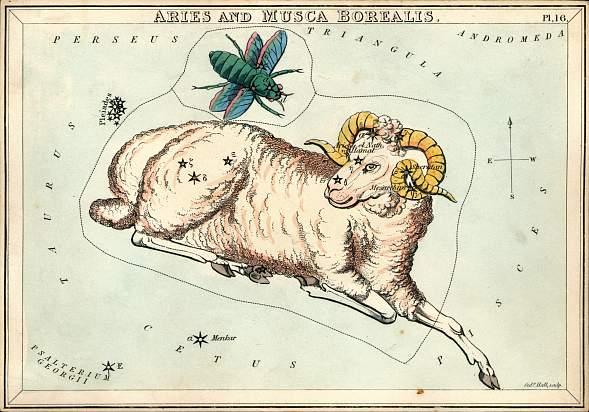
Taurus. For some reason, the half-shell of Taurus is hidden by some kind of cloud. Orion defends from Taurus.
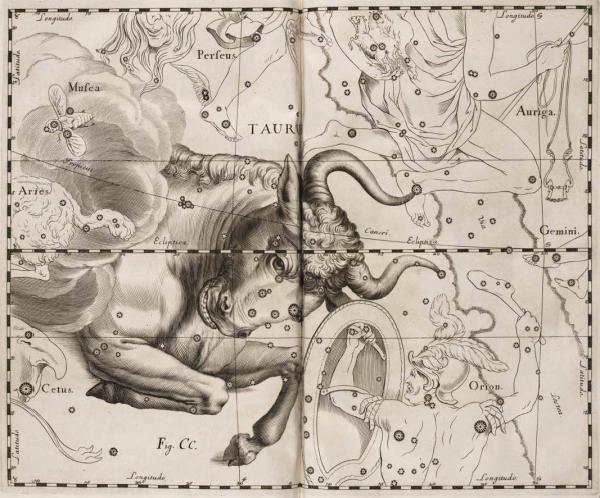
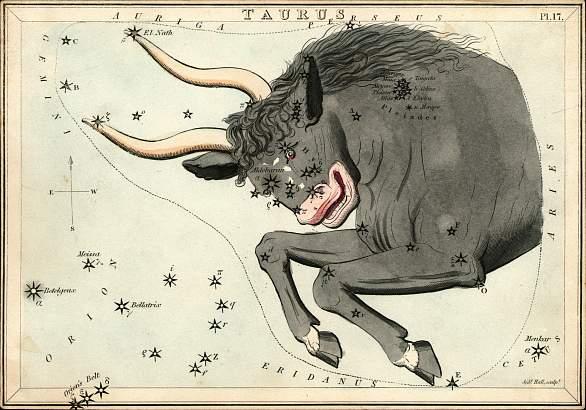
Twins- Castor and Pollux. On the right is Cancer, under Cancer is the Little Dog, on the shoulder blade of which is Procyon, one of the brightest (and fairly closest to us) star on the sky. To the left of the Dog, the head of the Unicorn is visible.

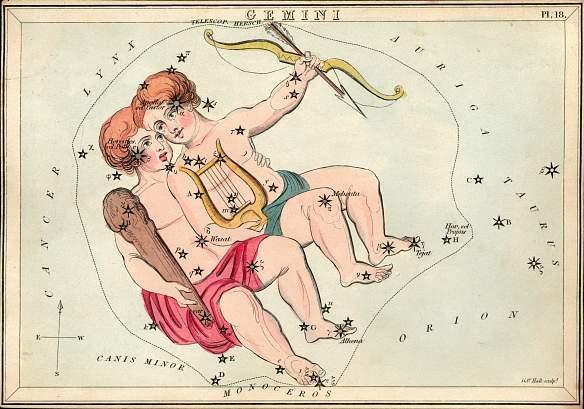
Crayfish

a lion. Under it - Sextant. Nose Leo tickles Cancer. Sextant is located beneath Leo, a new constellation introduced by Hevelius. To the left of the Sextant is the head of Hydra.
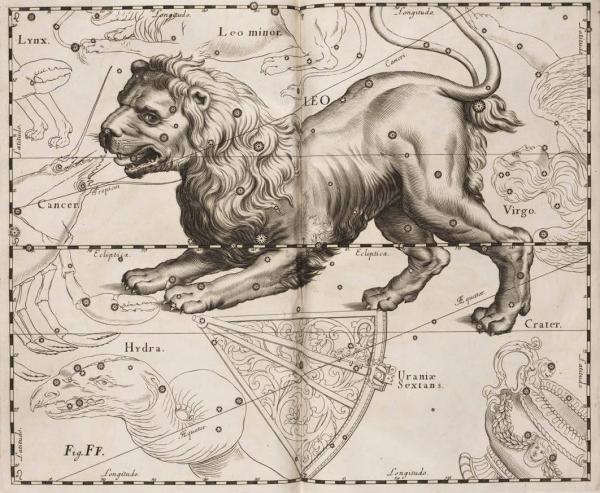
Small Lion (above) and Lion 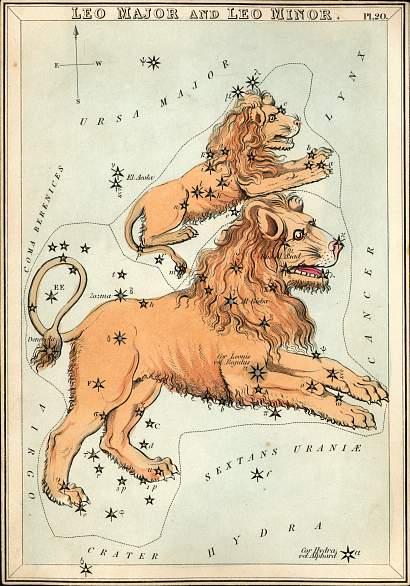
Virgo.Under it - the Chalice and the Crow, for some reason pecking Hydra. Above the foot of the Virgin, Hevelius placed Mount Menal (Latin Mons Menalus) - a constellation that was subsequently removed from star maps.
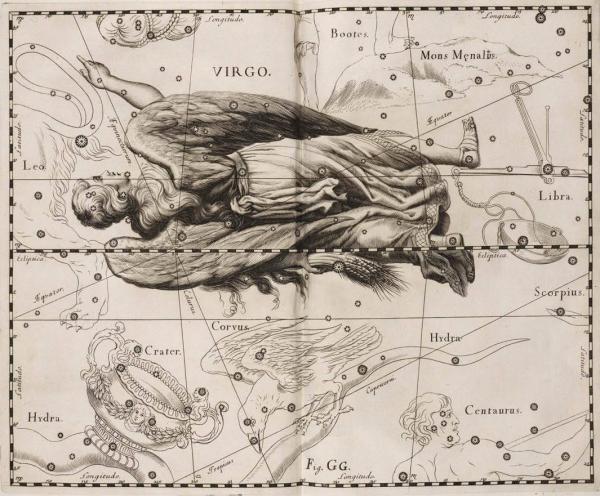
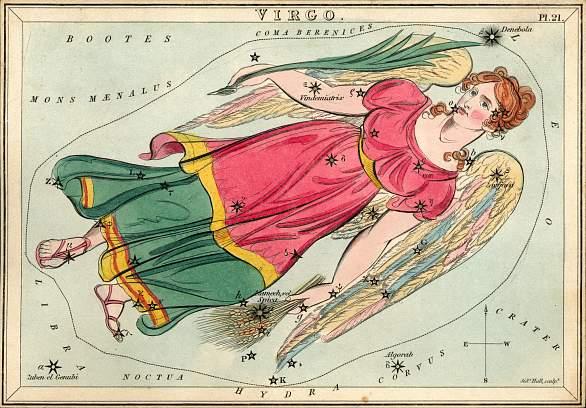
Libra.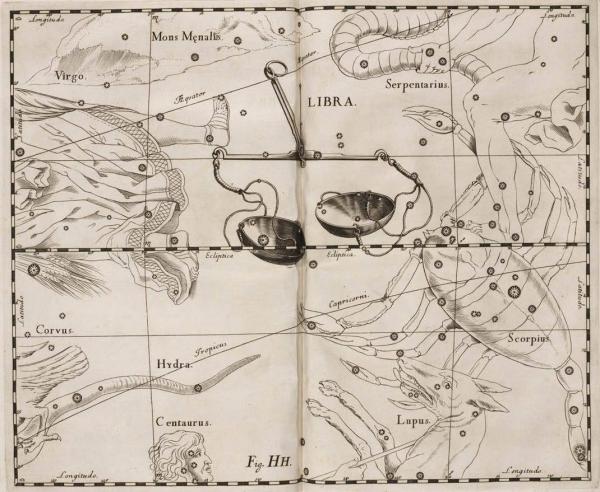
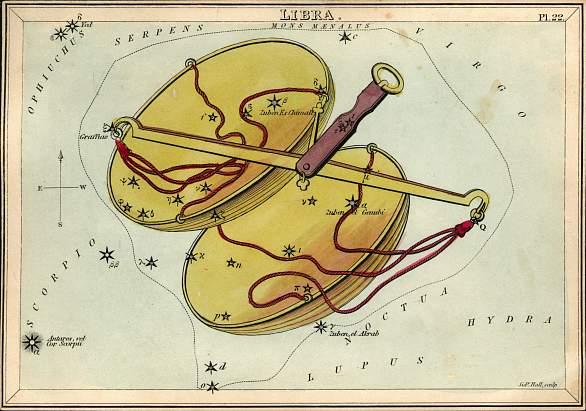
Scorpio.The Ophiuchus relies on it, a constellation that is not part of the Zodiac, but has a very significant part of the ecliptic in its "territory".
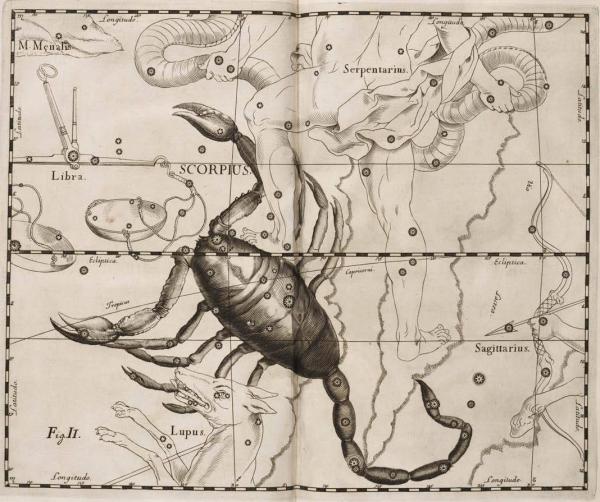

Sagittarius. Under the bow - the Southern Crown.
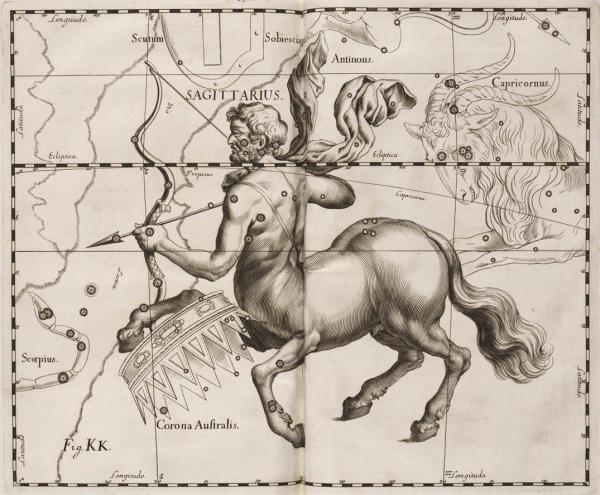
New constellations are visible here - Microscope (left) and Telescope. Both constellations were introduced by Nicola Louis de Lackaille in 1756. 
Capricorn 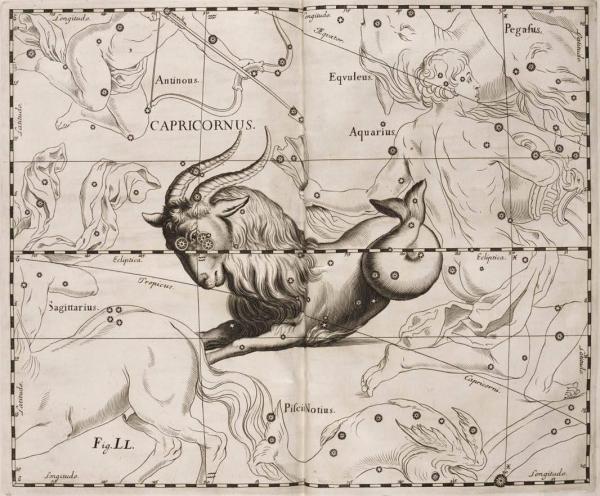
![]()
Aquarius 
Here, under Aquarius, on the right, you can see part of the constellation of the Balloon. It was proposed by Lalande in 1798 in honor of the Montgolfier brothers. Popular with astronomers did not use and was quickly forgotten. Under the foot of Aquarius, a part of the South Fish is visible, on the "field" of the map one of the stars Fomalgout, nearest to us, is indicated. 
Fish. Above the left fish Pegasus wing swung.
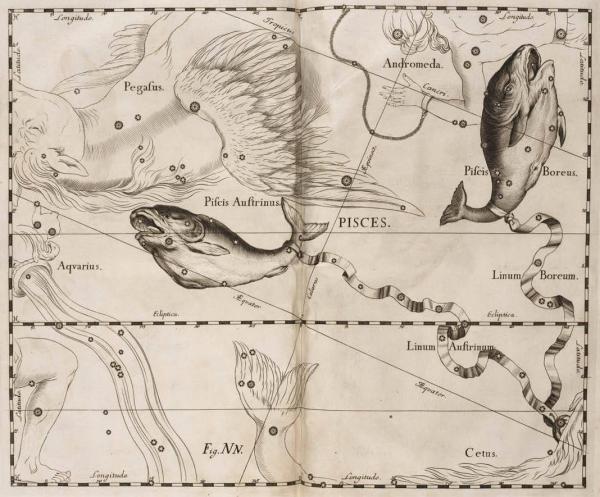
Non-diode constellations.
Ophiuchus As already mentioned, although Ophiuchi is not considered to be a zodiac constellation, the Sun spends 20 days in it: from November 21 to December 17.
It is interesting that although on this map Ophiuchus is designated as Serpentarius, its designation Ophiuchus is now adopted. 
Orion. One of the most noticeable and beautiful winter constellations. Known since antiquity. But in 1808, some German astronomers suggested renaming it after ... Napoleon. To the credit of the French astronomers, they rejected this idea.
To the right of Orion is the Unicorn (the constellation whose “discovery” is very mysterious), and beneath it the Hare is Orion's prey. 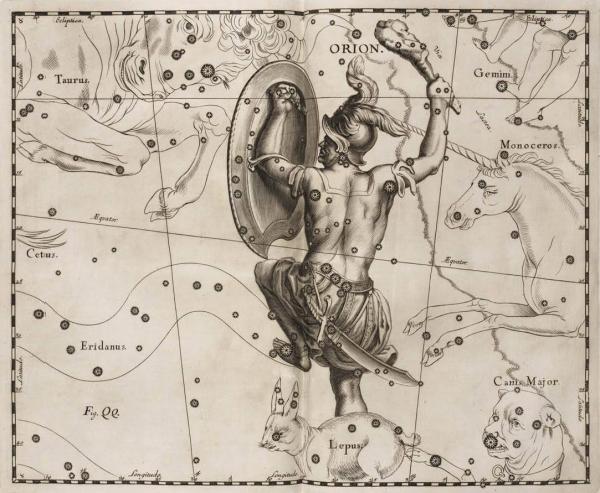
Famous Pegasus- "The horse of poets" :-) In front of him you can see the head of the Small Horse.

Hercules holds in his hand Cerberus (or Cerberus), a three-headed dragon-like dog. The constellation of Cerberus was introduced by Hevelius, but now it is not on the maps.
Later, the English cartographer John Senex invented the constellation of the Wind of Yabloni - the canceled constellation. It was an apple branch that Kerber entwined.
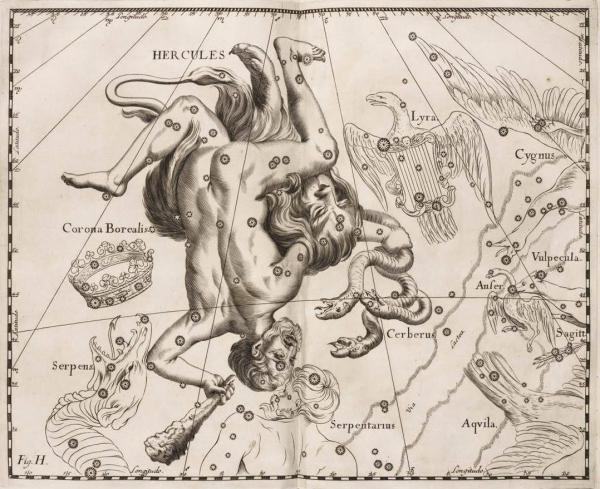
So hevelius represented Whale:

Lynx is a new constellation introduced by Hevelius. The motif is quite interesting: "in this part of the sky there are only small stars, and you need to have lynx eyes in order to distinguish and recognize them." 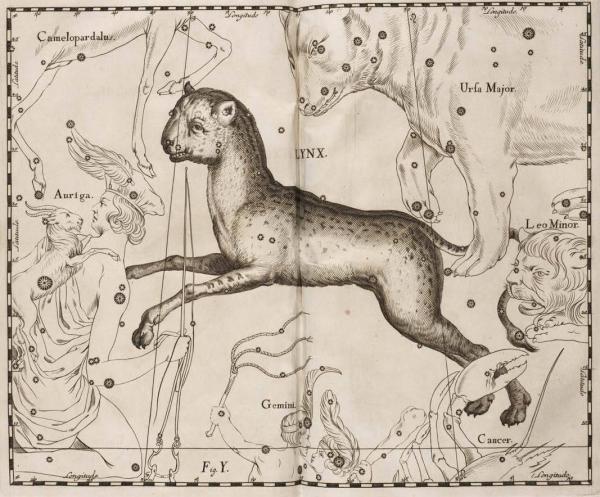
Well, I conclude the review with all known Ursa Major and Ursa Minor: 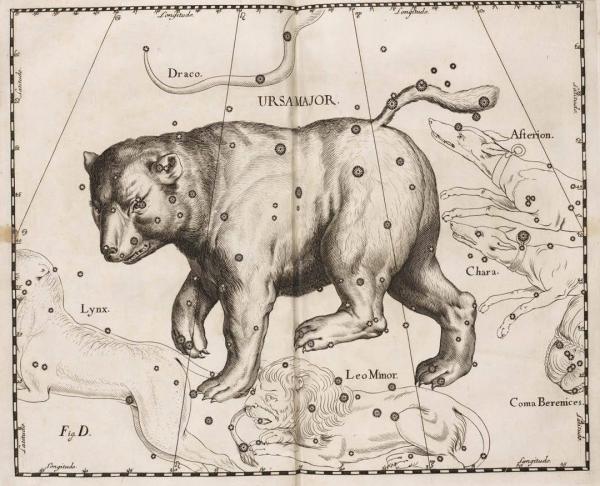
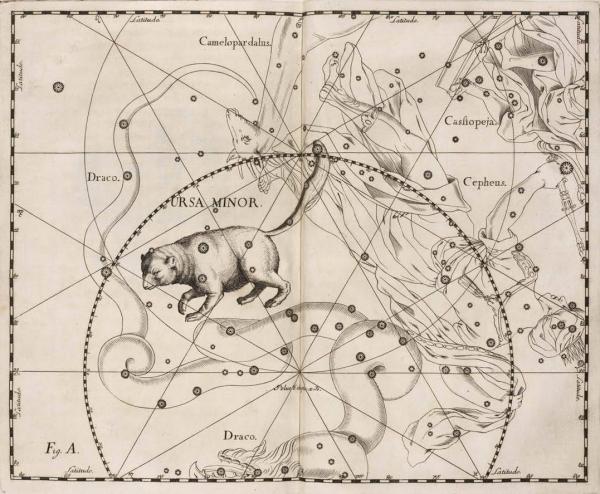
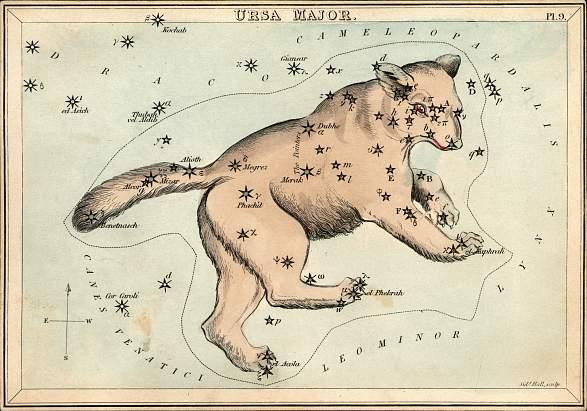
Sources: torrents.vtomske.ru, Wikipedia.
Since ancient times, people have been watching the night sky. There is something invariably attractive in the process of contemplating a clear month and distant stars. From all this, the soul is done well and peacefully.
An inquisitive observer will sooner or later begin to find patterns in the sky - bizarre clusters of stars, forming a variety of shapes. It will not go away from his attention and we will look at it in detail in our article.
Ursa Major in the view of ancient people
The Great Bear is one of the most ancient constellations of the night sky. Almost all peoples in the culture have references to this amazing cluster of stars.
The Hindu were the first to pay attention to it, giving it the beautiful name “Sapta Rishi”, which means “seven wise men” in Sanskrit. In Chinese astronomy, the constellation is called the Northern Bucket. Resourceful Chinese began to use it for timing.
The Greeks found the most interesting explanation for the beautiful cluster of stars in the sky. Of course, the Big Dipper is dedicated to the myth. It says that the domineering Zeus fell in love with the beautiful nymph Callisto. The imperious wife of Zeus, did not like it. In order to save the beautiful girl from the revenge of his powerful wife, the God of thunder turned her into a Bear and sent her to live in heaven. Now the beautiful Callisto pleases all lovers of the starry sky with her soft shimmering radiance.

Glowing bucket in the night sky
Now consider the Big Dipper bucket. In the autumn it is the most beautiful. Scientifically, the constellation is the third largest after Hydra and Virgo. Its size is 1280 square degrees. The Big Dipper (a bucket, the photo of which is shown below) has a visible part of seven bright stars. We list them:
- Dubhe - Bear;
- Merak - Loin;
- Thekda - Thigh;
- Megrets - The beginning of the tail;
- Aliot - Fat;
- Mizar - Gown;
- Benetnash - the leader of the mourners.
All Arabic names mean 7 bright stars that make up the legendary Bucket.
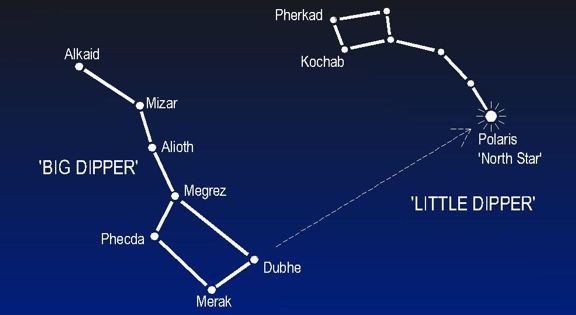
The sky
Starry sky is unthinkable without the constellation Ursa Major. The bucket in the fall is located in the northern part of the sky. It can be observed between 3-4 hours of night over the north-eastern horizon. A good guide will be his pen, indicating the place of sunrise.
Big Dipper - the path to knowledge of astronomy
Beginners need to learn how to find the Big Dipper bucket in the fall (photo of the constellation - below). This cluster of stars is one of the most visible in the night sky. Such an exercise will be a good preparation of young astronomy lovers for a more detailed study of the starry sky, namely:
- to finding less visible constellations in the sky. Advanced astronomers use Ursa Major as a guide to search for other stars;
- to an interesting observation of the sky throughout the year. You can see how familiar stars change their location, where a month rises, etc .;
- to conduct the first calculations. Over time, the person remembers the distance between the corner stars of the bucket;
- to the first skills with a handheld telescope. In the presence of this, the young observer of the sky will find stars that are invisible to the ordinary eye. Here we have in mind double and variable stars, there is a chance to even notice the exploding galaxy M82.
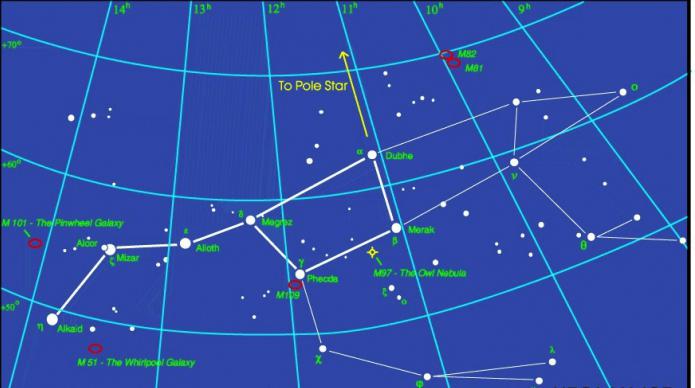
Big Dipper: bucket in autumn
Location constellations depends largely on the time of year. Ursa Major (dipper) in the fall is no exception to the rule.
The autumn sky is not rich in stars. Even the traditionally bright constellation Ursa Major glows dimly. Ursa Major's dipper is located in the north under the Polar Star in the fall; its tail is directed to the west. At the zenith is Cassiopeia.
But in the east, the Pleiades constellation rises high, under it the bright star Aldebaran, which is in the Taurus constellation, is clearly glowing. At this time, two bright stars ascend to the northeast: an experienced specialist in the starry sky immediately recognizes Gemini in them.
So, to summarize, what constellations can be seen in the autumn night sky in its northern part:
- Ursa Major;
- Little Dipper;
- Twins;
- Taurus;
- Lyra and the Swans.
Starry Geometry
Finding the Big Dipper's bucket in the fall, you can get carried away and devote an hour or two to finding other familiar stars. The most important thing is a sincere desire, and, of course, the night sky map will not hurt.
Let's look at the southern part of the sky. It is there that Andromeda and Pegasus rise every fall. In the upper left corner of the sky are the two stars of the first constellation, they are invariably followed by three stars of the second.
Andromeda consists of four stars located at a great distance from each other. The constellation itself is located under Cassiopeia. Andromeda resembles something like a bow. Directed last exactly in the direction of the Pleiades and Taurus. Even it seems that an arrow will now fly out of a bow and fly left, towards the indicated constellations. But this is certainly not the case. This is just a game of imagination, which has nothing to do with the majestic starry sky.
Under the Andromeda you can see two small stars - this is Aries. And under it scattered a lot of luminous points - it is only possible to see Aries and Keith during clear weather.
In Pegasus, in addition to three bright stars, there are two more to remember: they are located to the right. The very figure of Pegasus is similar to the horns. It seems that they want to pry Cygnus.
Picture: Big Dipper's bucket in autumn

Nothing is more conducive to creativity than observing a clear sky. Therefore, it is likely that you will "break through" to engage in some creative activity after the contemplation of the night luminaries. Someone wants to write a fascinating story about their nightly experience, someone wants to dance to their favorite music, and someone else to sketch a glowing bucket.
We will tell about the latest type of creative activity - about the sketch of the Bear.
To draw a bucket is elementary, because it is just a geometric figure consisting of an inverted trapezium and a broken straight line. But with the background, location and color of the picture you can experiment to your taste. Here everyone will have their own vision of the color and location of the bizarre figure on a piece of paper.
Try to put some feelings into the drawing, and then it will turn out really interesting. As you can see, it is not at all difficult to draw the Big Dipper's bucket in the fall.
Big Dipper in culture
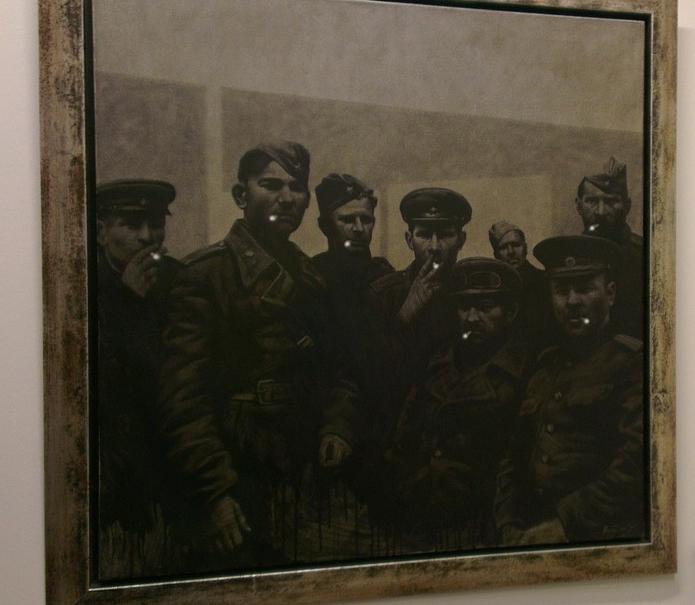
- constellation is asterism. This term refers to the funeral procession, followed by 2 stars Benetnash (2 mourners);
- the oldest name of the Big Dipper is Arktos. Refers to the prehistoric era of nomadic hunters. This once again confirms that people of all ages loved the starry sky;
- The Big Dipper (Bucket in Autumn) is depicted on the flag of Alaska;
- linked to anime. A character from the popular manga pro Kenshiro wears a scar on his chest in the form of a Bucket. To date, the Russian audience can enjoy the space three-part novella "Fist of the Northern Star: New Era";
- in the Museum of Modern Art there is the painting "Big Dipper". It is so named because the cigarettes of smoking people are arranged in a sequence that forms the figure of that very Bucket.
New Articles
- What is the highest peak of the Ural Mountains
- The most ancient religions in the world
- What continents are washed by the Atlantic Ocean?
- Can I wear jewelry of the deceased?
- Snake, Bowl and Staff: The Origin of Medical Symbols
- Interesting facts about hares
- Names of famous brands in other countries
- Karelo Finnish epic kalevala protagonists
- 17 18 weeks pregnant sensations
- Why do people become so aggressive
Popular articles
- Expression twice in one river, meaning and meaning
- Gusli - musical instruments
- Report: Temperature Scales and Thermometers
- Which side to sew on chevron
- How to draw emblems for school
- Unusual rivers of the world and the rivers of Russia - Rivers with sour water
- Numb of the little finger on the right hand: causes and methods of treatment
- Why development is important for a person
- Constellations from ancient atlases
- What happens at 31 weeks
